Numerology
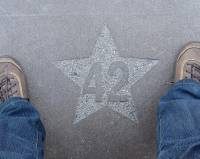
NUMEROLOGY: AN EXPERIMENT
Though much has been published about numerology, there have been few attempts to test the specific claims of this ancient art. In this simple piece of research, the widely accepted numerological idea that the number 7 is associated with being psychic, psychically aware or interested in psychic or paranormal matters was examined.
In theory it should be simplicity itself to test them. In the 'Hitch Hiker's Guide to the Galaxy' by Douglas Adams it is said that the answer to the question of life, the universe and everything is '42'. While many readers will no doubt find this concept amusing, there is more to it than may at first be seen. One of the most important questions of philosophy is that of determinism. Are the acts of living beings really the decision of free-thinking individuals or are they determined by some great universal principles, external forces or supreme beings? If numerology really works, it implies that there are deterministic principles at work in the universe at a much more fundamental level than our everyday physical plane.
This may seem a sweeping statement, so let me try to justify it. In numerology it is claimed that a person's character is enshrined in their given name. By using a simple numerical formula, a name is reduced to a single digit number. This digit is associated with a particular type of personality in the same way that sun signs are in astrology. But if this is true, it implies that the parents who gave that person his or her name were not acting through choice. Some universal principle was acting to give that child its name and make the parents think of it. What is more, the personality of the child, which many people think is heavily influenced by experience AFTER birth, is also predetermined to fit that given name. If that is not determinism I do not know what is!
I will not discuss numerology in detail but examine a test of just one prediction of the system. The numerological formula used here is called the Hebrew System. The system works by equating numbers to letters based on the Hebrew and Greek alphabets. When these ancient alphabets were used, there were no numbers as such. Letters were used to denote numbers, possibly explaining numerology. The table is:

The numerical value of each letter is added together eg. JOHN becomes 1 + 7 + 5 + 5 which makes 18. The digits of this number are then added together to make 9. In a similar way the digits of longer numbers are repeatedly added until a single one remains. Thus all words processed in this way are reduced to a number between 1 and 9. Each of these single-digit numbers is associated with a particular personality type. As can readily be seen, in all but the shortest of words, the final result of the calculation is almost entirely unpredictable by simply looking at the word. Thus, if numerology really works, it is unlikely that parents chose names with such things in mind.
The test
With such a simple formula, numerology should be very easy to test. One could compare the personalities of a sample group of people with their numerological numbers, for instance. In the test described here, ASSAP examined a specific prediction of numerology.
It is generally agreed in numerology that the number 7 is associated with people who are psychic or psychically aware. Thus it would seem a reasonable prediction that ASSAP members, who are interested in psychic matters, would contain a greater number of 7s in their ranks than the general population. This could test whether the association between the number 7 and the paranormal is correct. A second aspect of the test is to see if numerology has any objectively observable effects at all. If numerology is objective, it ought to produce unusually large or small groups of particular numbers for a given sample of the population.
The test was conducted by sending out a simple questionnaire to ASSAP members. They were asked to complete it themselves, and encourage any non-members they could find to do so as well (to provide a 'non psychic-aware' comparison group). The idea was to assess each of the answers using the numerology formula above. The questions consisted of four 'life facts'. The particular facts used were (1) the name the person is generally known by, (2) date of birth, (3) current home address and (4) birth place. Such facts are commonly used by numerologists to say something about the person concerned. Facts (2) and (4) are out of the control of the individual concerned. Facts (1) and (3), while under the control of individuals, are more frequently heavily influenced by external events or conditions. These facts are therefore essentially more or less random from a mathematical point of view.
As well as these 'life facts', there were some further questions on the form designed to determine how psychic or psychically aware the person was. The questions were (1) are you an ASSAP (or similar organisation) member, (2) have you ever had any apparently paranormal experiences, (3) do you regard yourself as psychic or sensitive and (4) how interested are you in the paranormal, on a scale of 0 to 5? The point of these questions was obviously to assess how psychic someone was and how interested in the paranormal. These factors could then be used to assess how 'sevenish' (ie. how psychic/psychically aware) a person was.
Comments on the protocol design
There are various points to be borne in mind about this simple experimental protocol:
- the answers received were taken at face value - no attempt was made to verify them in any way
- answers obviously depended on how they were understood by people filling in the form - they may therefore not be strictly comparable eg. does seeing a ghost once make you psychic?
- the handwriting on some forms was difficult to read
- there was a problem with the question 'Do you consider yourself as psychic or sensitive?' - some people seem to have treated this as a choice between 'psychic' or 'sensitive', though in fact it really meant 'Do you think you are psychic?' (with 'sensitive' meant to be a synonym)
To make the results easy to analyse arithmetically, some figures were used to assess the results. These were: (1) 'ASSAP membership' question: 0 = non-member, 1 = member, (2) 'Psychic experiences' question: 0 = none or 'No', 1 = 'few' (say 1-15 experiences), 2 = 'Yes' or 'some' (say 16-100), 3 = 'many' (say 100+), (3) 'Are you psychic?' question: 0 = 'No', 1 = 'slightly, a little etc', 2 = 'Yes', 'definitely' etc., (4) 'Interested in paranormal' question: scored as on form 0 - 5 where 0 = 'not interested' and 5 = 'extremely interested'.
The numerology calculation was done by a computer program. This meant that mistakes were minimised and the approach made consistent. Answers were generally left exactly as given on the returned forms eg addresses such as '4 The Cottages, Feltham' was as acceptable as a full version including the county and postcode. In the case of two questions, though, the answers were deliberately harmonised to allow comparison. All the dates were put into the format 'dd mm yyyy', eg. 12 2 1954. The birthplace was in the format of town or village and county.
The results
There were 96 forms returned. Some members got several of their friends to fill in forms. There were a lot of people who declared themselves to be very interested in the paranormal. The actual results are:
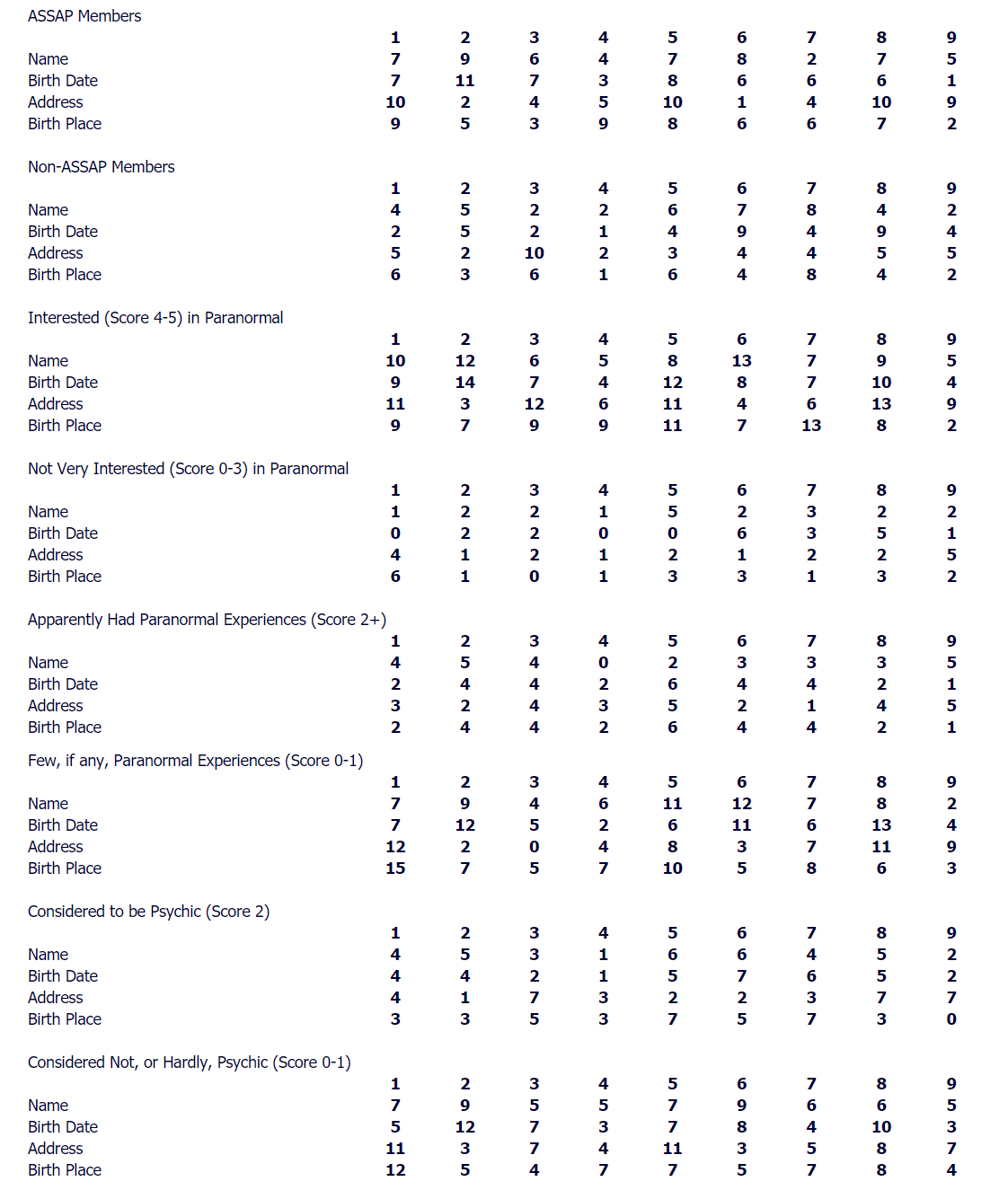
The tables show the number of times each numerological number occurred for each life fact shown. I have drawn my own conclusions from these tables but please feel free to use them to test your own theories. You must bear in mind, though, that this sample is not particularly large and so results cannot be taken as definitive.
Analysis of results
I combined all the results from each life fact (ie. name, birth date, address and birth place) and compared them by measures of 'psi-orientation' (ie. whether ASSAP members, interested in the paranormal, had experiences of, or apparent ability in, the paranormal). These were then plotted graphically (see below). The important point to note is whether any particular numbers occur significantly more frequently than average. This would indicate that a particular number might be significant for the actual group sampled. In this case we are looking to see if the number 7 attaches itself to the 'psi-orientated' group.
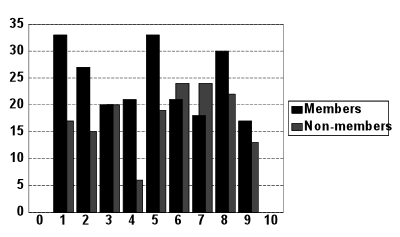
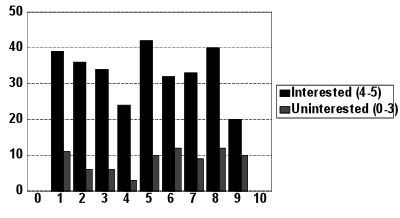
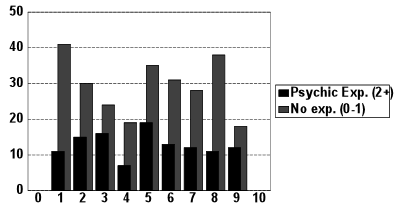
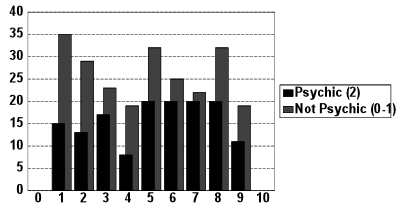
The most obvious point is that the number 7 does not stand out in the results where it should do (ie. for 'psi-orientated' people). Indeed the number 7 is actually shown to be rare amongst 'psi-orientated' people! A second important point is the wide range of results. In each of the graphs the lowest value is around half the highest value. This could indicate that the sample is too small to show anything of significance. Alternatively it could show that there is something non-random in the sample chosen. If there IS a 'number' for being psychic, the graphs would seem to show that 5 would a better bet than 7!
So is there ANY non-random pattern in the results? In figures 3 and 4 there are differences in the overall pattern of numbers between the 'psi' and 'non-psi' groups. These differences are not great though and the small number of people in the 'psi' groups makes any differences statistically insignificant. Figure 2 is disappointing in that there are so few people not interested in the paranormal - again making any possible conclusions problematical. Figure 1 is interesting in that there are two reasonably large groups to compare. There is a definite difference in the overall pattern of numbers found here, eg. compare the 'psi' peaks at 1, 5 and 8 with the 'non-psi' peaks at 3 and 6-7. This may possibly represent some sort of real difference between the groups, though it is certainly nothing as simplistic as'7 equals psi'.
Other results
It is possible to see other results in these data, not directly related to numerology. For instance, it is interesting to note that a large proportion of the sample is very interested in the paranormal. This is true even among non-ASSAP members. A smaller proportion of the sample claims to be psychic in some way or other. However, only a tiny proportion of the sample has actually experienced the paranormal first hand. It has been noted before that much of the population never (or hardly ever) experiences anything paranormal, while a few people experience things frequently. These data seem to bear this out.
Conclusions
The conclusion has to be that the '7 equals psi' prediction is not proved. There is a hint of some difference between ASSAP members and non-members but, if real, it is a subtle, complex effect. The sample was not big enough to make definitive statements and more data might make things clearer. In the oft repeated television series 'The Prisoner', Patrick McGoohan declares 'I am not a number, I am a free man!' On the evidence presented here we have to say that he is probably right but we await more data.
Numerology's most famous number
Probably the most famous number in numerology is 666 - the number of the beast - from the Book of Revelations. The famous magician Aleister Crowley called himself 'The Beast 666'. In a recent letter to the Sunday Times, Brian Gadd claims that Revelations was written as a veiled attack on the Jewish monastic system of 2000 years ago. The head of the monastic system had the title of 'beast' and a numerical 'rank' of 666. If this is so then the awe which 666 often inspires may be less justified than is generally imagined. There are several other similar theories of a mundane explanation for 666 which also involve the number representing a polemical target for the writer. Such hypothesised targets include the emperor Nero or the Roman empire itself.
Is nature random?
In nature numbers are NOT as random as one might imagine. Such numbers as the areas of lakes, tourist rates, house numbers etc. start more frequently with LOW digits than HIGH digits (eg 121, 346, 1065 etc rather than 97, 873, 8872 etc). This phenomenon, known as Benford's Law, is scale-invariant, ie. it does not matter if one uses hectares, acres or square yards to measure the surface area of lakes! It is perhaps no surprise that most house numbers begin with low digits, but why should it be so for natural features like lakes or essentially uncontrollable things like currency exchange rates? The only likely explanation suggested so far for this extraordinary law is based on the theory of chaos. The phenomenon appears to apply to bodies or systems consisting of large numbers of objects acting together. Such bodies or systems are known to be subject to the laws of chaos. See New Scientist, p12, 8 May 1993, Vol 138 No. 1872 'The Half-life of a Dirty Book' by Ian Stewart.
This article first appeared in Anomaly in 1993.